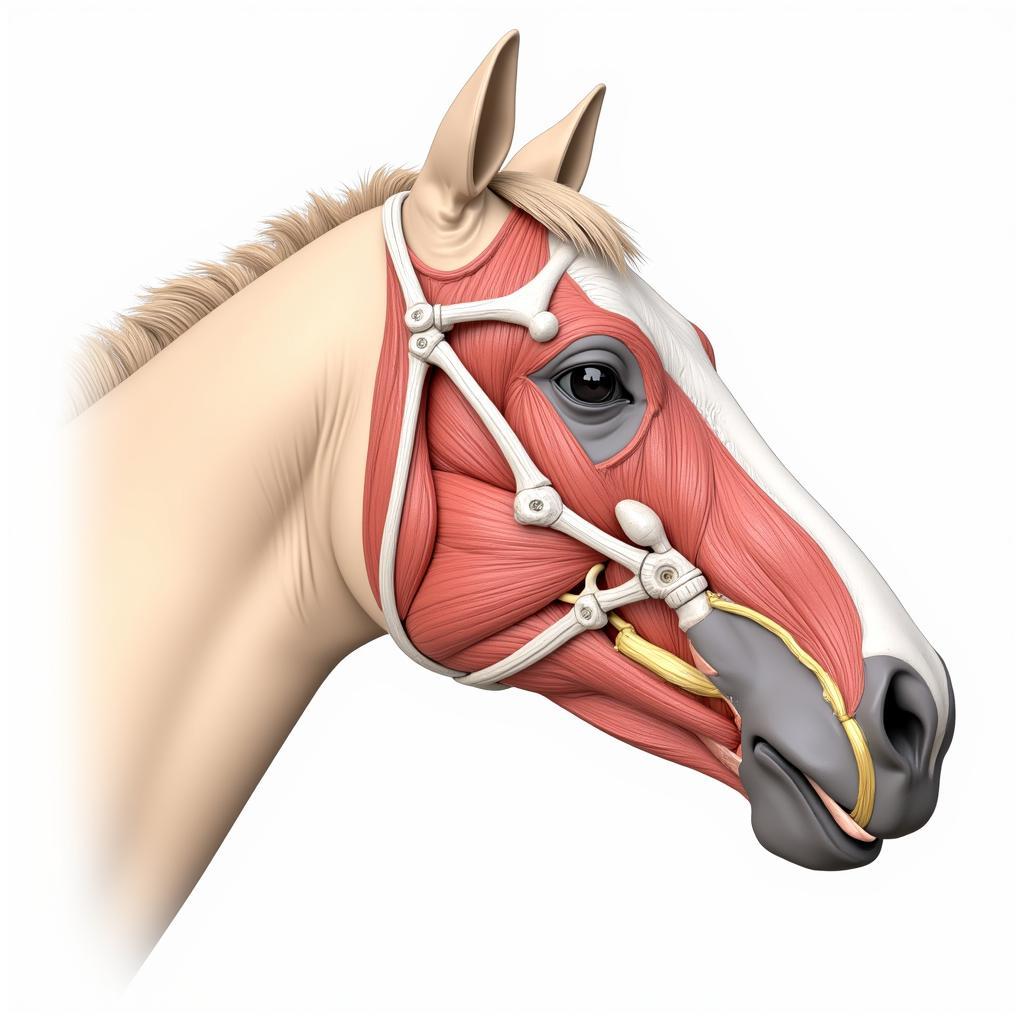The Horse Chin, a seemingly simple area of the horse’s head, plays a vital role in their overall well-being. It’s a central point for the attachment of important muscles related to chewing, swallowing, and head movement. Understanding its anatomy, recognizing potential problems, and providing proper care can contribute significantly to your horse’s comfort and health.
Anatomy of a Horse’s Chin
The horse chin is located at the lower front of the mandible, the largest bone in the horse’s skull. This area is covered by skin and a thin layer of subcutaneous fat. Several vital muscles attach to the mandible in the chin region, including those responsible for the movement of the jaw and lower lip. The chin also houses the incisor teeth, crucial for grazing and prehending food. Understanding the underlying structure of the horse chin can help you identify potential issues and provide appropriate care.
Just below the chin, you’ll find the intermandibular space, a vital area containing important lymph nodes. These lymph nodes are key components of the horse’s immune system, filtering lymph fluid and trapping pathogens. Swelling or tenderness in this area can indicate an infection or other health problem.
 Horse Chin Anatomy: A Detailed View
Horse Chin Anatomy: A Detailed View
Common Issues Affecting the Horse Chin
Several issues can affect a horse’s chin, ranging from minor irritations to more serious conditions. These can include:
- Trauma: Cuts, abrasions, and bruises can occur from falls, contact with fences or other objects, or even ill-fitting horse chin strap.
- Infections: Bacterial or fungal infections can develop in cuts or wounds on the chin. Swelling and discharge are common signs of infection.
- Dental problems: Issues with the incisor teeth, such as overgrown teeth or abscesses, can cause discomfort and affect the horse’s ability to eat.
- Bone spurs: These bony growths can develop on the mandible, particularly in older horses, and may cause pain or interfere with normal jaw movement.
- Tumors: While less common, tumors can occur in the chin region and may require veterinary intervention.
Recognizing these issues early is critical for effective treatment and preventing further complications.
Caring for Your Horse’s Chin
Regular inspection and proper care can help prevent many common chin problems. Here are some essential tips:
- Regular grooming: Clean the chin area daily with a soft brush or sponge to remove dirt, debris, and dried sweat.
- Inspect for injuries: Check the chin regularly for any cuts, abrasions, or swellings.
- Monitor eating habits: Observe your horse while eating for any signs of difficulty or discomfort, which could indicate dental problems.
- Properly fitted tack: Ensure that any tack, particularly bridles and horse chin strap, fits correctly and doesn’t rub or chafe the chin.
- Veterinary care: Consult your veterinarian if you notice any abnormalities or suspect a problem with your horse’s chin.
By incorporating these practices into your horse’s regular care routine, you can help maintain their chin health and overall well-being. Remember, prevention is always better than cure.
Why is Understanding the Horse Chin Important?
Knowing the structure and function of the horse chin helps owners recognize potential health problems. This knowledge enables them to address issues promptly, preventing further complications. A healthy chin contributes to the horse’s overall comfort and ability to eat effectively.
Conclusion
The horse chin, although often overlooked, is an important area deserving of attention. Understanding its anatomy, potential problems, and proper care practices is essential for every horse owner. By being proactive and vigilant, you can contribute significantly to your horse’s comfort, health, and overall quality of life. Remember, a healthy horse chin is indicative of a healthy horse.
FAQ
- What are the signs of a healthy horse chin?
A healthy horse chin is free of cuts, abrasions, swelling, and discharge. - How often should I clean my horse’s chin?
Ideally, the chin should be cleaned daily during grooming. - What should I do if I find a cut on my horse’s chin?
Clean the wound thoroughly and consult your veterinarian for further advice. - Can dental problems affect the horse chin?
Yes, issues with the incisors can cause discomfort and affect the chin area. - How can I prevent chin injuries in my horse?
Ensure proper tack fit, maintain a safe environment, and provide regular grooming. - Where can I find horse machine embroidery designs? Consider these horse machine embroidery designs.
- What’s a good option for a horse toy? A horse walking toy can be a great choice.
Common Scenarios and Questions
Scenario: Your horse has a small cut on its chin.
Question: Should I call the vet immediately? (Answer: For minor cuts, clean the wound and monitor. If it deepens, swells, or shows signs of infection, consult a vet.)
Scenario: You notice your horse is having trouble eating.
Question: Could it be a chin problem? (Answer: While it could be related to teeth or jaw issues affecting the chin, other problems might exist. Consult a vet to determine the cause.)
Further Reading & Related Topics
You might also be interested in articles on horse hitching rails: horse hitching rail.
Contact Us
For any assistance, please contact us: Phone: 0772127271, Email: [email protected] Or visit us at: QGM2+WX2, Vị Trung, Vị Thuỷ, Hậu Giang, Việt Nam. We have a 24/7 customer service team.